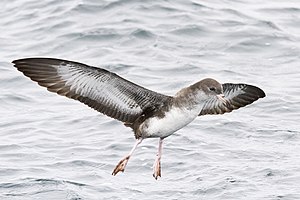Pink-footed Shearwater
| Pink-footed Shearwater | ||||||||||
|---|---|---|---|---|---|---|---|---|---|---|

Pink-footed Shearwater ( Puffinus creatopus ) |
||||||||||
| Systematics | ||||||||||
|
||||||||||
| Scientific name | ||||||||||
| Puffinus creatopus | ||||||||||
| Coues , 1864 |
The pink-footed shearwater ( Puffinus creatopus ), sometimes also called the yellow-footed shearwater , is a pelagic seabird belonging to the tube-nosed order . The species is widespread in the Pacific region .
features
The pink-footed shearwater has a head-torso length of about 48 cm and weighs about 900 g. The beak is colored light pink with a black tip, the feet and legs also have a pink color. The entire top of the body and wings is grayish-brown, while the underside of the body is white. With the exception of the dark edges, the underside of the wings is mainly white, but shows varying grayish-brown markings.
distribution
Pink-footed shearwaters breed exclusively on the three Chilean islands of Santa Clara , Robinson Crusoe and Isla Mocha , which are off the west coast of South America . Outside the breeding season, the birds cover considerable distances and fly over large parts of the Pacific region. The species is mainly observed on the American coast. Here their distribution area extends from southern Alaska to Chile. But it has been spotted even before New Zealand and Australia . Evidence is even known from the Argentine Atlantic coast .
Way of life
The pink-footed shearwater feeds mainly on small fish such as sardines and squid . Crustaceans are also consumed less frequently. The foraging takes place in deep sea waters and on the continental shelf , less often on the coast . The prey is caught by shock diving just below the surface of the water.
At the beginning of the breeding season between October and November, the birds gather at their breeding grounds (excluding the three Chilean islands of Isla Mocha, Robinson Crusoe and Santa Clara) where they form breeding colonies of several thousand birds. The individual pairs breed on the ground. Gaps in the earth, burrows or the birds nest between exposed roots serve as nesting places. The egg-laying takes place in December, the young birds are up early in May into it in April fledge .
Duration
The IUCN lists the pink-footed shearwater population as "vulnerable", so the total population is viewed as endangered. It is currently estimated that there are around 20,000 active breeding pairs, more than half of which breed on Isla Mocha. The world population of the pink-footed shearwater is estimated at a maximum of 100,000 individuals. Since the species only breeds on three islands, the total population is accordingly susceptible to any dangerous environmental changes that may take place there.
literature
- Barrie D. Heather, Hugh A. Robertson: The Field Guide to the Birds of New Zealand . Penguin Books, London 2005. ISBN 978-0-14-302040-0
Web links
- Ardenna creatopus inthe IUCN 2013 Red List of Threatened Species . Listed by: BirdLife International, 2012. Retrieved September 25, 2013.
- BirdLife International: Species Factsheet - Pink-footed Shearwater ( Ardenna creatopus ) . Retrieved September 25, 2013.
- Videos, photos and sound recordings of Pink-footed Shearwater (Puffinus creatopus) in the Internet Bird Collection
- Pink-footed shearwater ( Ardenna creatopus ) at Avibase; Retrieved September 25, 2013.
- Puffinus creatopus in the Integrated Taxonomic Information System (ITIS). Retrieved September 25, 2013.
- xeno-canto: Sound recordings - Pink-footed Shearwater ( Puffinus creatopus )
